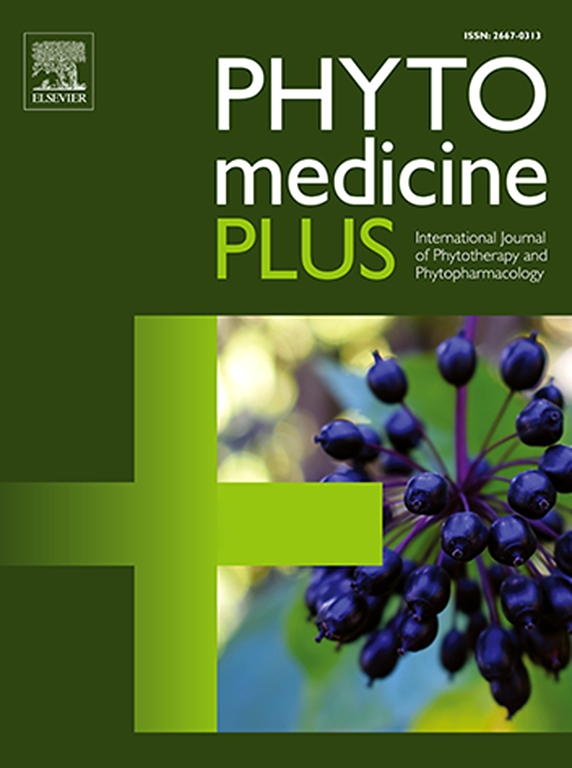Breaking the biofilm barrier: Juglone derivatives as dual-action inhibitors and anti-quorum sensing agents
Q3 Pharmacology, Toxicology and Pharmaceutics
引用次数: 0
Abstract
Background
Most nosocomial infections are caused by bacteria that proliferate within quorum sensing mediated biofilms. The disruption of quorum sensing signals in biofilm-forming bacteria is the potential substitution strategy.
Purpose
The current study focuses on the evaluation of isolated juglone derivatives from Reynoutria japonica as anti-biofilm agents and enzyme inhibitors against Methicillin Resistant Staphylococcus aureus (MRSA).
Methods
The antibacterial and anti-biofilm activity of the juglone derivatives were investigated against laboratory strains MRSA using well and disc diffusion method. In addition, we evaluated the anti-biofilm inhibition potential of the juglone derivatives using a crystal violet-based assay in 96-well micro-titer plate. The suppression of S. aureus β-hemolytic, coagulase and proteolytic activity was evaluated using standard assay protocols. High Performance Liquid Chromatography (HPLC) was performed to analyze the acyl homoserine lactones (AHLs) signals degradation by juglone derivatives. Furthermore, all three ligand molecules were docked into the binding site of the S. aureus coagulase protein.
Results
All the three juglone derivatives showed potent antimicrobial activity against clinical strains of MRSA. Among these compounds, 2-ethoxy-6-acetyl-7-methyljuglone displayed potent inhibitory activity with zones of inhibition of 15 ± 0.03 and 17 ± 0.03 against MRSA respectively. In the spectrophotometric assay, we confirmed that juglone derivatives inhibit biofilm formation. All the compounds markedly inhibited the coagulase, β-hemolytic and proteolytic activity of MRSA. The application of compounds as a treatment resulted in a notable decrease in biofilm density and thickness, as demonstrated by HPLC. The untreated MRSA exhibited quorum sensing signals of N-Butanoyl-l-homoserine lactone (C4-HSL) with retention time 3.6 min and of N-hexanoyl-l-Homoserine lactone (C6-HSL) at 5.8 minutes’ vs the treated with MRSA where no peaks were observed. The docking studies and Molecular dynamics (MD) simulation results revealed that all molecules are actively binding in the target site that correlates well with the in-vitro inhibitory properties of compounds against S. aureus.
Conclusion
our results demonstrated the potential of juglone derivatives from R. japonica as a promising anti-biofilm agent and as quorum quencher for future therapy to combat multi-drug resistant infections in particular MRSA.

突破生物膜屏障:核桃酮衍生物作为双作用抑制剂和反群体感应剂
背景:大多数医院感染是由细菌在群体感应介导的生物膜内增殖引起的。生物膜形成细菌中群体感应信号的破坏是潜在的替代策略。目的评价从日本野鼠中分离得到的核桃酮衍生物作为抗甲氧西林耐药金黄色葡萄球菌(MRSA)的生物膜剂和酶抑制剂的作用。方法采用孔扩散法和圆盘扩散法研究核桃酮衍生物对MRSA实验室菌株的抑菌活性和抗生物膜活性。此外,我们在96孔微滴度板上使用结晶紫法评估了核桃酮衍生物的抗生物膜抑制潜力。对金黄色葡萄球菌β-溶血酶、凝固酶和蛋白水解活性的抑制作用采用标准测定方案进行评估。采用高效液相色谱法(HPLC)分析了核桃酮衍生物对酰基高丝氨酸内酯(AHLs)信号的降解。此外,所有三个配体分子都停靠在金黄色葡萄球菌凝固酶蛋白的结合位点上。结果3种核桃酮衍生物对MRSA临床菌株均有较强的抑菌活性。其中,2-乙氧基-6-乙酰基-7-甲基核桃苷酮对MRSA表现出较强的抑制活性,抑制区分别为15±0.03和17±0.03。在分光光度分析中,我们证实了核桃酮衍生物抑制生物膜的形成。所有化合物均能显著抑制MRSA凝固酶、β-溶血和蛋白水解活性。高效液相色谱法显示,化合物作为处理的应用导致生物膜密度和厚度显著降低。未处理的MRSA表现出n -丁醇-l-高丝氨酸内酯(C4-HSL)的群体感应信号,保留时间为3.6 min,而n -己醇-l-高丝氨酸内酯(C6-HSL)的群体感应信号在5.8 min,而MRSA处理后没有观察到峰。对接研究和分子动力学(MD)模拟结果显示,所有分子都在靶点上积极结合,这与化合物对金黄色葡萄球菌的体外抑制性能密切相关。结论本研究结果表明,金盏花核桃酮衍生物作为抗生物膜剂和群体淬灭剂,在未来治疗多重耐药感染特别是MRSA方面具有广阔的应用前景。
本文章由计算机程序翻译,如有差异,请以英文原文为准。
求助全文
约1分钟内获得全文
求助全文
来源期刊

Phytomedicine Plus
Medicine-Complementary and Alternative Medicine
CiteScore
3.70
自引率
0.00%
发文量
178
审稿时长
81 days
期刊介绍:
 求助内容:
求助内容: 应助结果提醒方式:
应助结果提醒方式:


